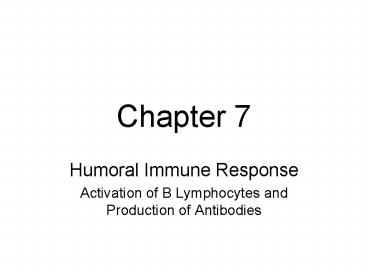Humoral Immune Response PowerPoint PPT Presentation
1 / 18
Title: Humoral Immune Response
1
Chapter 7
- Humoral Immune Response
- Activation of B Lymphocytes and Production of
Antibodies
2
Antibodies
- Part of the adaptive immune response functions to
neutralize and eliminate extracellular microbes
and microbial toxins - More useful against polysaccharide and lipids and
these types of toxins B cells respond to many
Ag types - Naïve B cells recognize Ag but cant make Ab
until activation allows differentiation to Ab
secreting
3
Phases and Types of HIR
- Naïve B-cells have 2 classes of membrane bound Ab
IgM and IgD - act as receptor for Ag
- Activation of Ag specific cells leads to clonal
expansion - Go from 1 to 4000 Ab secreting cells
- Differentiation into effector cells secreting Ab
- secreted Ab is same specificity of as naïve
membrane bound receptor but during
differentiation can cause Ab with different heavy
chain and effector function heavy chain class
(isotype) switching - can handle different types of microbes
- Repeated exposure to causes Ab with increasing
affinity to Ag affinity maturation - improved Ab
4
Recognition and Activation
5
T-Cell Dependence??
- Ab response to different Ag depends on the
requirement of T-cell help - B-cells recognize many Ags protein,
polysaccharide, lipid and small chemicals - T-cells that recognized Ag play role in
activation and powerful inducer of isotype
switching - no T-cell protein Ag makes poor or no Ab
response T-dependent to get good Ab - Polysaccharidde, lipid and non-protein Ag
stimulate Ab production without T helper cells
T independent - little heavy chain switching or affinity
maturation
6
Responses
- Ab responses differ qualitatively and
quantitatively - 1? response is the first time exposed
- small amounts of Ab produced
- 2? response is the subsequent exposure
- more Ab produced
- if to a protein, see isotype switching and
affinity maturation - increase in TH cells with repeated stimulation
- Ag recognition ACTIVATES B-lymphocytes
7
- Must be able to tell the difference between 1?
and 2? responses
8
Stimulation of B-Cells by Ag
- Initiated when Ag-specific B-cells in lymphoid
follicles of the spleen, LN and mucosal lymphoid
tissues recognize Ab - Ag of microbes in tissues or blood are
transported and concentrated in B-cell rich
follicles how is not well defined - Ag without processing NATIVE CONFORMATION
- triggers signaling pathways
- requires 2nd signals produced during innate
immune response
9
Ag-Induced Signaling in B-Cells
- Membrane Ig receptors cluster (bind and move
together) and trigger biochemical signals that
are transduced by receptor-associated signal
molecules - similar to T-cells activation
- must cross-link 2 or more receptors for signal
transduction 2 or more Ag in an aggregate or
repeating epitopes of one Ag molecule binds
adjacent Ig molecules - Polysaccharide, lipid and other non-protein Ag
have multiple identical epitopes in each molecule
(bind numerous Ig receptors on B-cell) - transduced by receptor-associated proteins
10
Signals
- Receptor IgM and IgD highly variable with short
cytoplasmic domains - recognize Ag but do not transduce signals
- IgM and IgD are non-covalently linked to Ig? and
Ig? to make the B-cell receptor (BCR) complex - Ig? and Ig? contain conserved immunoreceptor
tyrosine-based activation motifs (ITAM) seen in
other activation receptors - 2 or more Ag receptors cluster, Tyr in ITAM of
Ig? and Ig? are phosphorylated by kinase
associated with BCR complex - Tyr-PO4 is the docking sites for adaptor protein
which gets phosphorylated and recruits a number
of signal molecules - Signal cascade not as well understood as T-cells
but essentially similar activates trnscription
factor that turn on genes whose proteins involved
in B-cell proliferation and differentiation
11
B-Cell Activation
- Syk is similar to ZAP-70
12
Complement and B-Cell Activation
- B-cells express receptor for a complement protein
which provides signals to activate B-cells when
bound to ligand - Complement is activated by microbes and Ab
attached to microbes functions as effector
mechanism of host defense (Chapter 8)
13
Complement Activation of B-Cells
- Microbe has C3d (cleavage product of C3) coating
the surface - B-cells has type 2 complement receptor (CR2 or
CD21) and it binds to C3d - B-cells recognize microbe Ag by the Ig receptor
and also recognizes C3d on CR2 receptors - C3d acts as the 2nd signal for B-cell activation
- CR2 enhances Ag-dependent activation of B-cells
- Ag recognition is 1st step
14
Activation
- Microbes themselves or innate immune response to
microbes provide signals in addition to Ag
recognition to activate lymphocytes - C3d is similar to co-stimulators in T-cell
activation
15
Consequences of Ag-Mediated B-Cell Activation
- Initiate B-cell proliferated and differentiation
- Prepare B cells to interact with TH cells if
protein Ag - B-cell enters cell cycle and proliferates
clonal expansion - Produces more IgM and secrete IgM early phase
immune response induced
16
Early Phase is Greatest
- Response is greatest for polysaccharide and
T-independent Ag - multivalent
- cross-links many Ag-receptors
- activates C strongly
- Proteins cant do the 1st 2 so make weak response
without TH response - lack multiple, identical epitopes
17
Additional Steps
- At least 3 other changes to the B-cell to enhance
ability to interact with TH cells acting as APC - increase the expression of B7 costimulator
molecule (2nd signal for T-cells) - expression of cytokine receptors cytokine
mediators of TH cells - decrease the expression of chemokine receptors
chemokines keep B-cell in follicles, without
chemokines they can migrate out of follicle to
where TH cells are
18
Function of T-Helper Cells
- Required for strong response to protein Ag
- B-cell and T-cell must recognize protein Ag and
come together to stimulate B-cell proliferation
and differentiation in the lymphoid tissue

